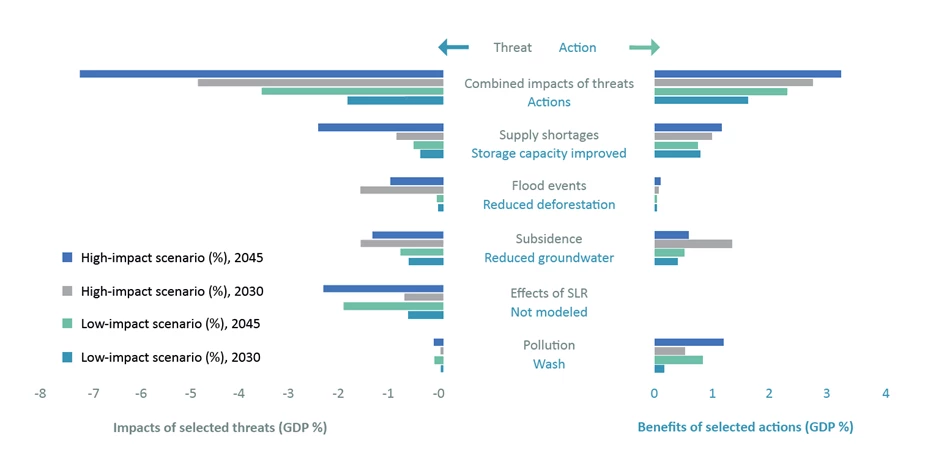![Jakarta City Skyline. Photo by © [Daxiao Production] / Adobe Stock Jakarta City Skyline. Photo by © [Daxiao Production] / Adobe Stock](https://s7d1.scene7.com/is/image/wbcollab/adobestock_15449962_-_copy?qlt=90&fmt=webp&resMode=sharp2) Jakarta City Skyline. Photo by © [Daxiao Production] / Adobe Stock
Jakarta City Skyline. Photo by © [Daxiao Production] / Adobe Stock
Indonesia’s Vision 2045 sets out an ambitious target to transform the country, already the largest economy in Southeast Asia, into the fifth largest economy in the world. But to achieve this goal, the archipelagic state – one of the most populous and natural disaster-prone countries in the world – will have to achieve much greater water security. What effects will overuse, wastage, pollution, and uncoordinated development have on the country’s ability to accelerate economic growth when some islands are already experiencing water shortages?
To help answer this question, the Global Water Security & Sanitation Partnership (GWSP) supported a comprehensive water sector diagnostic for Indonesia alongside a series of stakeholder consultation platforms to not only quantify the impact of water-related threats on GDP and overall socioeconomic development, but also help the government outline sectoral priorities with a clear evidence-based narrative.
The resulting report “Indonesia Vision 2045: Towards Water Security,” developed together with the Indonesian Ministry of National Development Planning (BAPPENAS) and the World Bank, finds that without dedicated action on water security, the country will fall short of its Vision 2045 GDP target by up to 7.3 percent (See Fig.1).
Conversely, if the country successfully acts on the report’s nine actions, structured in three main pillars covering: (i) water threats; (ii) water services; and (iii) water governance, it would be possible to exceed its 2045 GDP target by up to 3.2 percent (See Fig.1).

Pillar I. Managing water resources sustainably and strengthening resilience to water threats
Water demand is continuing to rise quickly as a result of demographic and economic growth and is expected to increase by 31 percent between 2015 and 2045. Yet today, half of the country’s GDP is produced in river basins that suffer “high” or “severe” water stress in the dry season, with water stress an increasing concern for many islands, especially the high-density island of Java. Meanwhile, more than half of Indonesia’s rivers are heavily polluted.

Pillar I. Actions
- Reduce localized water stress by optimizing scarce resources in future development planning.
- Significantly reduce water pollution, especially from agriculture and aquaculture, and increase the treatment of municipal, industrial, and mining wastewater.
- Enhance sustainability and improve resilience to disasters.
Pillar II. Improve the inclusivity, sustainability, and efficiency of water services
Water supply services and access to sanitation fall well short of usual standards at Indonesia’s level of development and far below the aspirations of Vision 2045. Agriculture uses 80 percent of Indonesia’s water, yet nearly half (46 percent) of irrigation systems are classed as “in poor condition”.
Pillar II. Actions
- Accelerate inclusive, sustainable, and efficient water supply for all Indonesians
- Expand and finance inclusive, sustainable, and efficient sanitation services and wastewater treatment
- Modernize irrigation and improve its productivity
Pillar III. Strengthen governance and institutions for sustainable and efficient water management
Indonesia’s water governance framework is affected by regulatory uncertainty, overlapping and fragmented mandates, and insufficient resource allocation.
Pillar III. Actions
- Strengthen the governance framework
- Strengthen coordination and capacity of institutions
- Improve the efficiency of public expenditures for water and mobilizing finance
Looking ahead to 2045
Carrying out this agenda for Indonesia will require political commitment at both central and decentralized levels together with the collaboration of many institutions. To that end, a series of webinars are being organized around the key topics of the report, with nationally and internationally renowned speakers that bring the report to life to a wide audience of national stakeholders. These webinars have generated large interest, attracting well over 500 attendees each.
Through the process of developing this report, the GWSP has helped lay the groundwork for the cooperation necessary to carry out the recommendations therein. The GWSP facilitated policy dialogue with 34 government directorates under 16 ministries and agencies related to the water sector in order to inform key decision-makers of the challenges and potential solutions presented in the diagnostic. In addition, the Partnership helped create a platform for discussions with central, provincial, and local governments.
Given Indonesia’s diversity of water security challenges—spanning from water stress in Java to lack of access to safe water in Papua— the agenda on water is vast. But concerted, collaborative, and sustained action to combat water threats puts Indonesia’s Vision 2045 firmly within reach.
RELATED


Join the Conversation